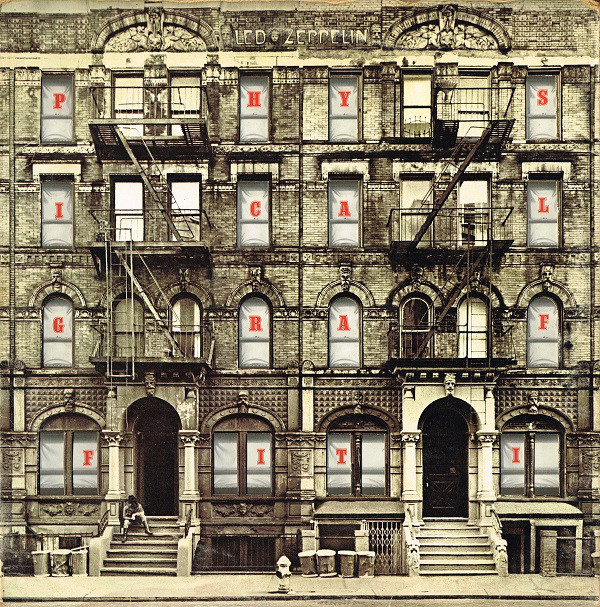
Physical Graffiti (1975)

Disc One
1. Custard Pie
2. The Rover
3. In My Time of Dying
4. Houses of the Holy
5. Trampled Underfoot
6. Kashmir
Disc Two
7. In the Light
8. Bron-Yr-Aur
9. Down By the Seaside
10.Ten Years Gone
11.Night Flight
12.The Wanton Song
13.Boogie With Stu
14.Black Country Woman
15.Sick Again
If there’s a definitive argument for the double album in rock, Physical Graffiti might just be it. Not that casual fans would know. Glance at the track list and, aside from Kashmir, you’re not likely to find many familiar titles. But for the committed—for those who’ve ventured past the overplayed surface of Zeppelin’s catalog—this is often considered their crowning achievement. Some of the band members have even gone on record to say so. And, frankly, it’s difficult to argue.
It wasn’t originally meant to be a double album. The band went into the studio with a single LP in mind, only to realize they had too much quality material to squeeze onto one disc. So they did what any band at the height of their powers would do: dusted off a handful of outtakes from earlier sessions, stitched them into the new material, and inadvertently created one of the most complete, ambitious, and downright electrifying double albums in rock history.
Despite its sprawling length, Physical Graffiti isn’t nearly as eclectic as one might assume. The through-line is still firmly rock and roll—albeit a version of it that encompasses blues, folk, funk, and the occasional Eastern flourish. Take In My Time of Dying, for example: a gospel-blues standard previously tackled by the likes of Blind Willie Johnson and Bob Dylan. Zeppelin, unsurprisingly, blow it wide open, stretching it into an eleven-minute epic powered by Bonham’s thundering kit and Page’s jagged slide work. It’s blues reimagined for a coliseum.
And then there’s Kashmir. What more can be said? A minor-key dirge spun into grandeur, the song’s vaguely "Indian" motif has often led to geographic confusion, though no one’s mistaking this for actual South Asian folk music. It’s still rock—just recontextualized, adorned, and given the illusion of mysticism. The rhythm is hypnotic, the strings are cinematic, and Plant’s vocals—equal parts menace and majesty—seal it as one of their most iconic statements.
Elsewhere, the album manages to flex without faltering. The lovely instrumental Bron-Yr-Aur provides a moment of acoustic serenity (not to be confused with the more rustic Bron-Y-Aur Stomp from Led Zeppelin III), while Down by the Seaside evokes a laid-back, almost Neil Young-esque warmth. Tracks like Boogie with Stu (featuring the late, great Ian Stewart on barrelhouse piano) and Black Country Woman flirt with country-rock and pub-blues in ways that feel lived-in rather than labored.
What makes Physical Graffiti so endlessly listenable, even decades on, is precisely what sets it apart from the band’s more famous works: these songs haven’t been bludgeoned into banality by classic rock radio. You’re not likely to stumble upon The Rover, Sick Again, or Ten Years Gone during your morning commute. They still belong to the album—and to those who take the time to discover them there.
Unbeknownst to fans at the time, Physical Graffiti would mark the beginning of the end. Personal tragedies, excess, and the slow erosion of momentum would cast long shadows over the band’s next two releases. While their latter records have their moments, neither comes close to matching the sprawl, scale, and sheer inspiration on display here. Zeppelin would never soar quite this high again—but when they did, they left behind a monument.
Go back to the main page
Go To Next Review